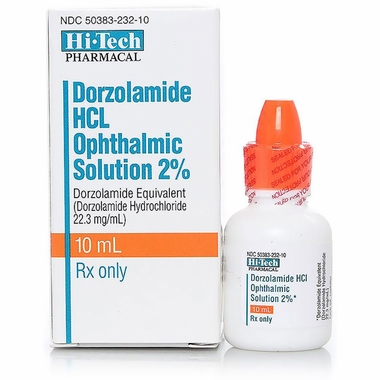SAVE 15% OFF 15% OFF Use Code EPX15 *

Dorzolamide HCl Ophthalmic Solution 2%, 10ml
- Description
- Ingredients
- Directions
- FAQ
- Reviews
Description
Dorzolamide is used as a treatment for glaucoma, and is often prescribed by veterinarians for use with dogs and cats. This drug contains a carbonic anhydrase inhibitor which decreases intraocular pressure, a characteristic of many types of glaucoma. (Manufacturer may vary)
Key Benefits
- Reduces pressure in the eye due to glaucoma
- Controls production of fluid, particularly within the eye
- Reduces risk of nerve damage and loss of vision
How It Works
Dorzolamide HCl inhibits carbonic anhydrase II. Inhibition of carbonic anhydrase decreases aqueous humor secretion, presumably by slowing the formation of bicarbonate ions with subsequent reduction in sodium and fluid transport. The result is a reduction in intraocular pressure (IOP).
Indications
Dorzolamide HCl Ophthalmic Solution is a carbonic anhydrase inhibitor indicated in the treatment of elevated intraocular pressure in patients with ocular hypertension or open-angle glaucoma.
Ingredients
| Active Ingredients (per ml) | Amount |
|---|---|
| Dorzolamide Hydrochloride | 22.3 mg/ml |
| Benzalkonium Chloride (preservative) | 0.0075% |
| Other Ingredients: Hydroxyethyl Cellulose, mannitol, sodium citrate dihydrate, sodium hydroxide (to adjust pH) and water for injection. | |
Directions
Use Dorzolamide HCl exactly as directed by your veterinarian. If you do not understand these directions, ask your pharmacist or veterinarian to explain them to you. Always wash your hands before and after applying this medication. Apply the medication to the pets eye by pushing on the "Finger Push Area" of the bottle which then releases a single drop of the medication. If you are using another eye drop in your pet, wait 10 minutes between use of different medications. Do not touch the dropper to any surface, including the eyes and hands. If it becomes contaminated, it could cause an infection in the eye. Do not use if the eyedrop is discolored or has particles in it. Store Dorzolamide HCl at room temperature away from moisture and heat. Protect from light. Keep the bottle properly capped.
- Dorzolamide HCl Sterile Ophthalmic Solution is a prescription medication used in dogs and cats to reduce pressure inside the eye by reducing the amount of fluid in the eye.
- Dorzolamide HCl Sterile Ophthalmic Solution is also used to treat high blood pressure in the eye due to open-angle glaucoma.
- Dorzolamide HCl Sterile Ophthalmic Solution is a prescription medication not FDA approved for veterinary use; however, it is a commonly accepted practice for veterinarians to prescribe this medication for dogs and cats.
Tip: Do not touch the dropper to any surface, including eyes and hands. The dropper is sterile. If it becomes contaminated, it could cause an infection of the eye. Do not use if the eye drop is discolored or has particles in it. Dorzolamide HCl Sterile Ophthalmic Solution may cause blurred vision.
| Dorzolamide HCl Dosage for Cats | |
|---|---|
| Weight | Dosage |
| All weights | The usual dose is 1 drop in the eye 3 times a day. Apply this medication to the pet's eye by pushing the 'Finger Push Area" of the dropper bottle which then releases a single drop of the medication. If you are using any other eye drop in your pet's eye, wait 10 minutes between the use of different medications. |
| Dorzolamide HCl Dosage for Dogs | |
| Weight | Dosage |
| All weights | The usual dose is 1 drop in the eye 3 times a day. Apply this medication to the pet's eye by pushing the 'Finger Push Area" of the dropper bottle which then releases a single drop of the medication. If you are using any other eye drop in your pet's eye, wait 10 minutes between the use of different medications. |
Caution:
Disclose all medications you are giving to your pet to your veterinarian. If any side effects occur (swelling, hives, difficulty breathing), stop using Dorzolamide HCl on your pet and contact your veterinarian. Do not touch the dropper to any surface, including the eyes and hands. If it becomes contaminated, it could cause an infection in the eye.
Precautions:
Dorzolamide HCl Ophthalmic Solution contains dorzolamide, a sulfonamide; and although administered topically, it is absorbed systemically. Therefore, the same types of adverse reactions that are attributable to sulfonamides may occur with topical administration of Dorzolamide HCl Ophthalmic Solution.
This drug is FDA-approved for human use. However, it is common practice for veterinarians to prescribe such drugs for use in dogs and cats.
NOTE: For Generic Medications, picture displayed may not depict actual product. Generic medications may vary from one order to the next by size, color and shape depending on manufacturer.
Possible Side Effects:
The most frequently reported adverse reactions associated with Dorzolamide HCl Ophthalmic Solution were ocular burning, stinging, or discomfort immediately following ocular administration (approximately one-third of patients). Approximately one-quarter of patients noted a bitter taste following administration. Superficial punctate keratitis occurred in 10 to 15% of patients and signs and symptoms of ocular allergic reaction in approximately 10%.
Storage:
Store this product at room temperature, away from moisture and heat. Keep the tube properly capped.
FAQ
Reviews
- Fast service
- None


